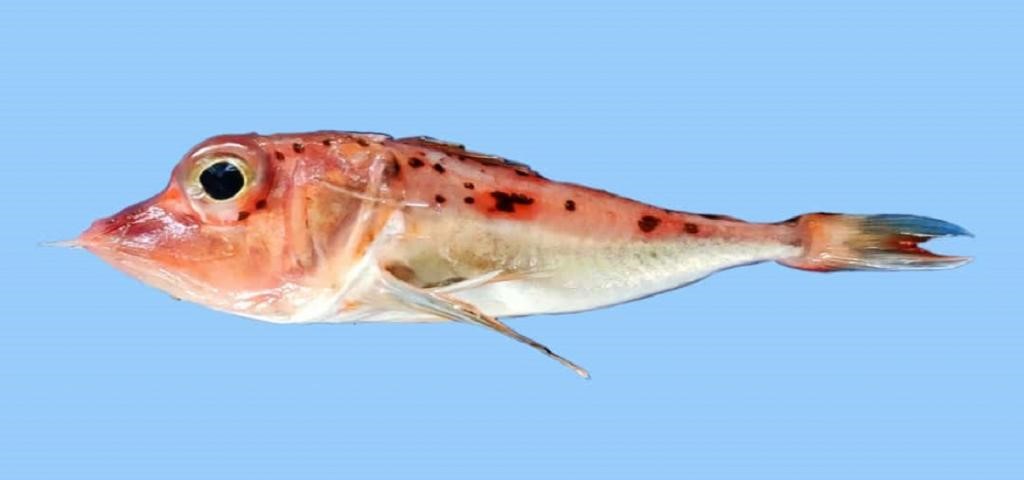Description

Disclaimer: Copyright infringement not intended.
Context
- The scientists of the Zoological Survey of India (ZSI) have discovered a new species of a vibrant orange coloured deep water marine fish from Digha Mohana in West Bengal.
Details
Discovery and Identification
- Scientists from the ZSI discovered a new species of deep-water marine fish in Digha Mohana, West Bengal.
- The new species belongs to the family Triglidae and is commonly known as gurnards or sea-robins.
- Named Pterygotrigla intermedica, it shares characteristics with other gurnad species, particularly Pterygotrigla hemisticta.
Rarity and Significance
- This discovery is significant as it adds to our understanding of marine biodiversity, especially in Indian waters.
- Pterygotrigla intermedica is only the fourth species of the Pterygotrigla genus reported in India to date.
- Worldwide, the Triglidae family comprises a total of 178 species, making this family of fishes ecologically significant.

Unique Characteristics
- Notable features of this new fish species include a distinct pectoral fin with black membranes on the inner surface, a white posterior margin, and three small white spots basally in the fin. Each ray is creamy white.
- It has a long opercular spine and a very short cleithral spine.
- Other distinguishing traits include the pattern of lateral-line and gill rakers on the first gill arch.
- A large black blotch is observed between the 4th and 6th spines of the first dorsal fin.
About Pterygotrigla genus
- It is a group of marine fish commonly known as gurnards or sea-robins.
- These fish belong to the family Triglidae and are known for their distinct physical characteristics and habitat preferences.
Physical Characteristics:
- Gurnards from the Pterygotrigla genus are known for their unique and eye-catching physical features.
- They typically have elongated bodies with large pectoral fins.
- The pectoral fins often have striking coloration, including various shades of red, orange, and yellow.
- These fish have spiny, armored heads with a prominent snout.
Habitat and Distribution:
- Species within the Pterygotrigla genus are primarily found in deep-water habitats.
- They are often associated with continental slopes and deep-sea environments.
- The genus has a wide distribution, with various species located in different parts of the world's oceans, including the Indian Ocean.
Feeding Habits:
- Gurnards are carnivorous and feed on a diet that includes small fish, crustaceans, and other benthic organisms.
- They use their specialized pectoral fins to "walk" along the ocean floor in search of prey.
Taxonomy:
- The Pterygotrigla genus belongs to the larger Triglidae family, which is commonly referred to as the "sea robins."
- Within this genus, there are multiple species, each with its unique characteristics and distribution.
Ecological Role:
- Gurnards play a role in marine ecosystems by controlling populations of smaller organisms and contributing to the overall food web.
Fisheries and Conservation:
- Some species of gurnards, including those within the Pterygotrigla genus, are of commercial interest in fisheries due to their taste and texture.
- Sustainable fishing practices are essential to ensure the conservation of these species and their habitats.
.jpg)
Conclusion
The discovery of Pterygotrigla intermedica in the waters of Digha Mohana highlights the rich biodiversity of India's marine ecosystems and the ongoing efforts by scientific organizations like the ZSI to document and understand these valuable natural resources.
|
PRACTICE QUESTION
Q. Which of the following statements about the Pterygotrigla genus is correct?
- They are primarily found in shallow coastal waters.
- Their pectoral fins are not known for any distinct coloration.
- Gurnards within this genus have short snouts.
- They are part of the Triglidae family.
A) 1 and 2
B) 2 and 3
C) 3 and 4
D) 1 and 4
Correct Answer: D) 1 and 4
|
https://www.downtoearth.org.in/news/wildlife-biodiversity/new-fish-species-discovered-in-bengal-s-digha-harbour-91875












